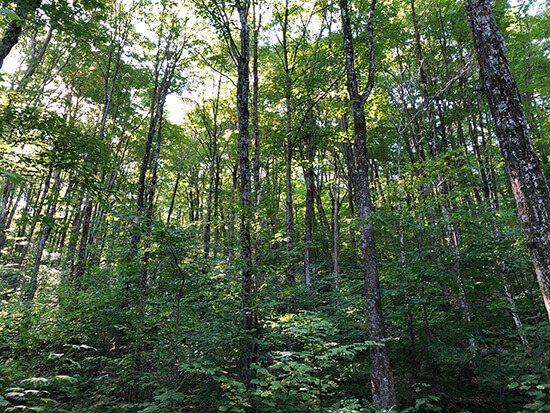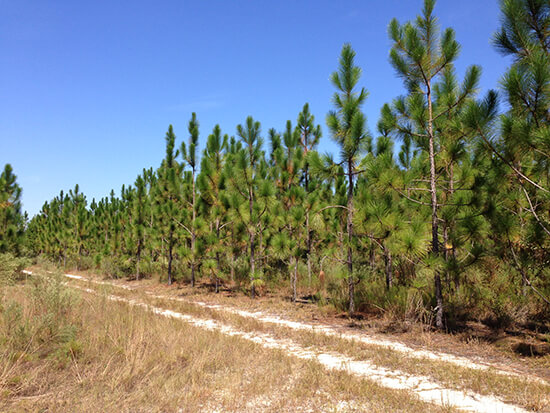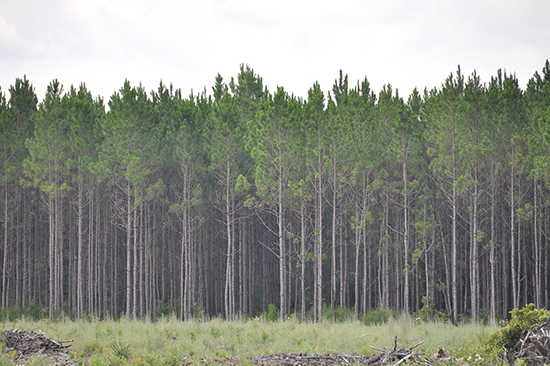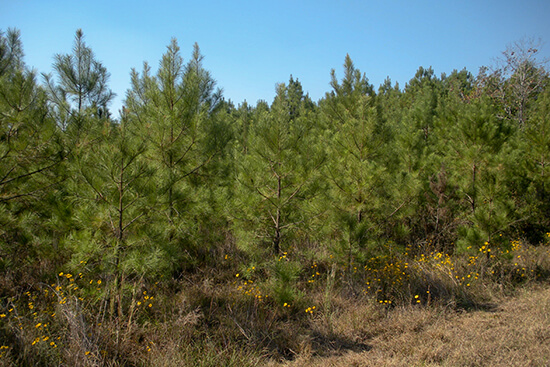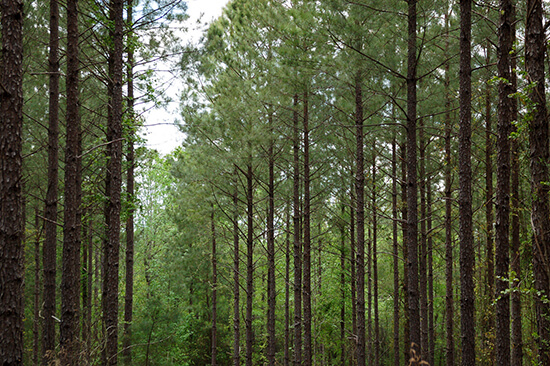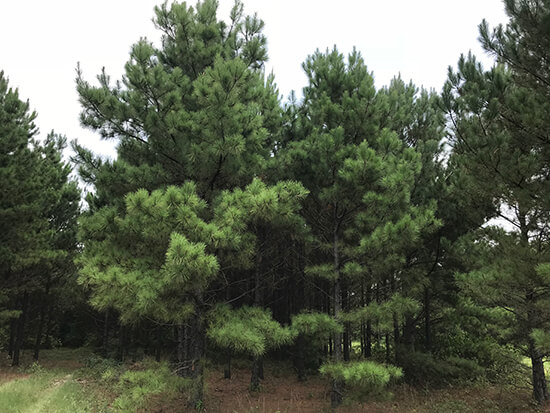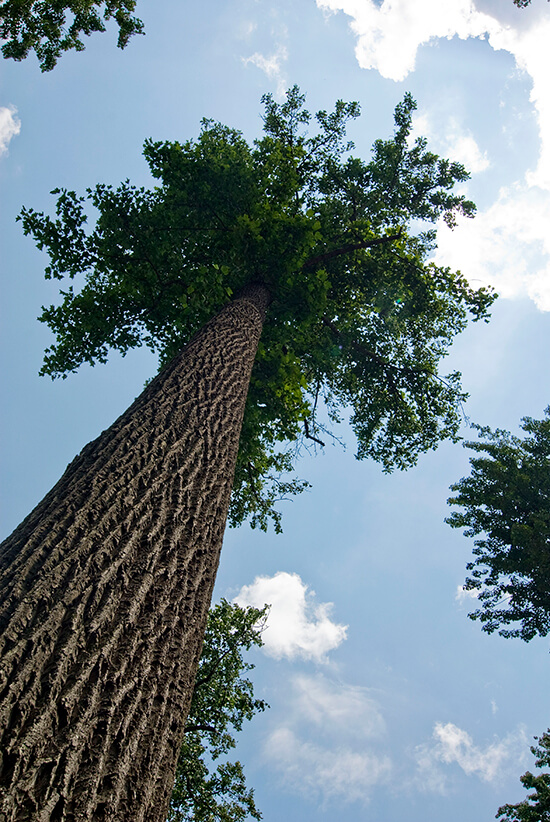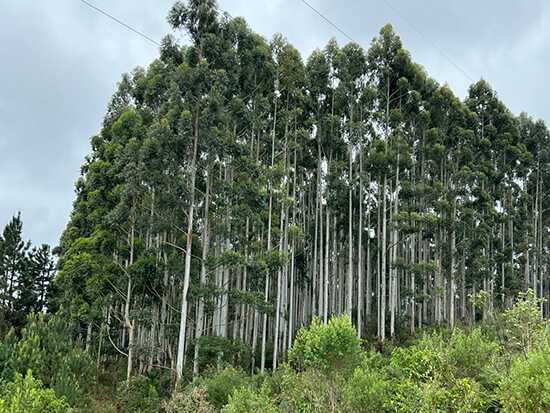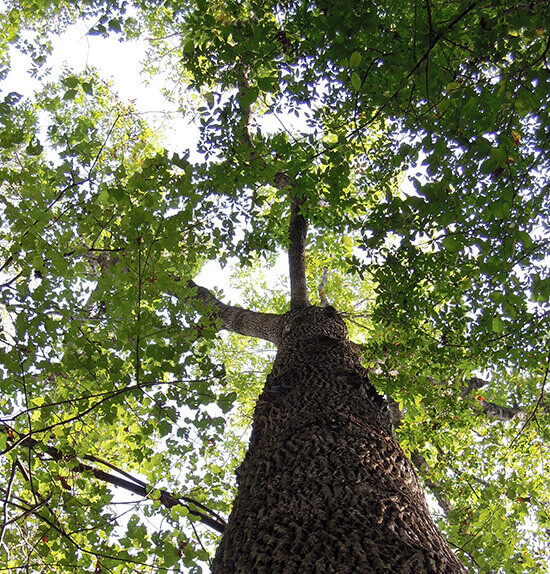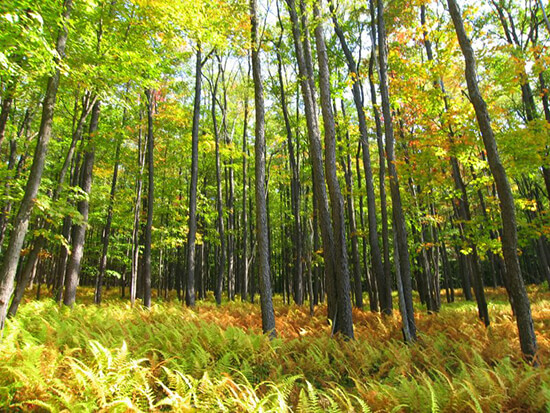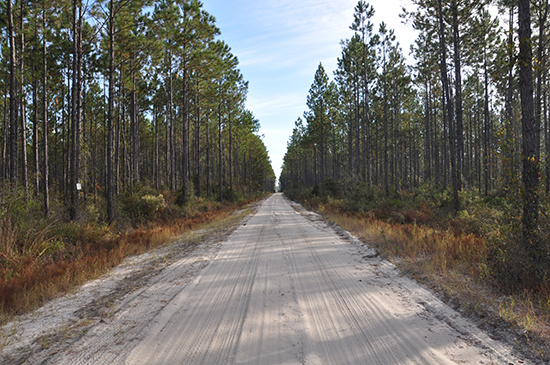The Glossary has been included to provide a resource to the website user.
Glossary of Terms
a
Access road
A temporary or permanent road over which timber is transported from a loading site to a public road. Also known as a haul road.
Advanced regeneration
Trees that have become established naturally under a mature forest canopy and are capable of becoming the next crop after the mature crop is removed.
Aerial photogrammetry
Interpreting information from aerial photographs.
Aerial photography
Photos taken from the air at regular, spatial intervals and used in photo interpretation to provide information about forests and landforms.
Age
Mean age of the trees comprising a forest, crop, or stand. In forests, the mean age of dominant (and sometimes codominant) trees is taken. The plantation age is generally taken from the year the plantation was begun, without adding the age of the nursery stock.
Age class
Any interval into which the age range of trees, forests, stands, or forest types is divided for classification. Forest inventories commonly group trees into 20-year age classes.
Artificial regeneration
Establishment of the forest by planting or direct seeding; Renewal of a new stand of trees by planting seeds or seedlings by hand or machine.
Aspect
The direction toward which a slope faces.
Azimuth
The horizontal angle or bearing of a point measured from the true (astronomic) north. Used to refer to a compass on which the movable dial (used to read direction) is numbered in 360°.
b
Backfire
Blaze set in front of an advancing forest fire in an e ffort to check the wildfire by cutting off its fuel supply.
Bare-root seedling
Tree seedling grown in a nursery bed. When large enough for transplanting, the seedling is lifted from the nursery bed, and the dirt is removed from the roots before packaging. (as opposed to container or plug seedlings)
Bark beetle
Small, cylindrical beetle of the family Scolytidae, the adult of which bores into and beneath the bark of various trees (i.e. southern pines) for the purpose of egg laying.
Basal area
Cross sectional area of a tree, in square feet, measured at breast height. Used as a method of measuring the volume of timber in a given stand.
Basal area factor
Number of units of basal area per acre (or per hectare) represented by each tree.
Bays
Depression areas characterized by wet soils and swamp vegetation.
Bearing tree
Tree marked to identify the nearby location of a survey corner. Also known as a witness tree.
Bedding
A site preparation technique whereby a small ridge of surface soil is formed to provide an elevated planting or seed bed. It is used primarily in wet areas to improve drainage and aeration for seeding or planting.
Berm
Outside or downhill side of a ditch or trench.
Best Management Practices (BMPs)
State or local regulatory or non-regulatory guidelines for proper application of forestry operations, including protecting water quality as required by federal statutes, including the Clean Water Act and Water Pollution Control Act. BMPs are primarily designed to prevent soil erosion and water pollution, and to protect certain wildlife habitat values in riparian and wetland areas. Click here to visit a website containing specific information on BMPs and water quality.
Biltmore stick
Graduated stick used to estimate tree diameters when held at right angles to the axis of the stem and comparing the graduations cut by lines of sight tangential to either edge of the stem.
Biodiversity
the range of species variety and quantity that occurs across the landscape.
Biomass
Total woody material in a forest. Refers to both merchantable material and material left following a conventional logging operation.
Biota
All living organisms of an area, taken collectively.
Blaze
To permanently mark trees, indicating those to be harvested or the course of a boundary, road, or trail.
Blowdown (windthrow)
Uprooting by the wind. Also refers to a tree or trees so uprooted.
Bog
Wetland consisting of saturated organic material, such as peat and muck, and plants that tolerate acidic soils, such as sedges and bog laurel.
Bole
The main stem of a tree.
Bolt
Short piece of pulpwood.
Branchwood
Wood portions of a tree excluding the stem and roots.
Breast height
The standard height, 4.5 feet (1.3 m) above ground level, at which the diameter of a standing tree is measured.
Broad-based dip
A surface drainage structure specifically designed to drain water from an access road while vehicles maintain normal travel speeds.
Broadcast burn
Controlled fire used as a silvicultural treatment to burn a designated area within well-defined boundaries for the purpose of reducing fuel hazards. Also called slash burning.
Browse
Buds, shoots and leaves of woody plants that serves as food for wildlife, or the eating of same by wildlife.
Brush
Small trees and shrubs.
Bucking
The act of cutting a felled tree into specified log lengths for yarding and hauling; also, making any bucking cut on logs.
Buffer strip or buffer zone
Strip of undisturbed vegetation (timber) between cutting units or adjacent to another resource (streams, etc.). Also known as a green strip, leave strip or buffer area.
Bureau of Land Management
The Bureau of Land Management (BLM), an agency within the U.S. Department of the Interior, administers 264 million acres of America's public lands, located primarily in 12 Western States. The BLM, as stated in their mission statement, sustains the health, diversity, and productivity of the public lands for the use and enjoyment of present and future generations.
Butt rot
Decay or rot characteristically confined to the base or lower bole of a tree.
c
Cambium
Layer of living cells between the wood and the innermost bark of a tree. Each growing season the cambium adds a new layer of cells (by cell division) on the wood already formed, as well as a layer of inner bark on the cambium's outer face. Division of these cells results in diameter growth of the tree through formation of wood cells (xylem) and inner bark (phloem).
Canopy
More or less continuous cover of branches and foliage formed collectively by adjacent tree crowns.
Canopy closure
The progressive reduction of space between crowns as they spread laterally, increasing canopy cover.
Cant
Log that is squared on two or more sides.
Carrying capacity
The average number of livestock and/or wildlife that can be sustained on a management unit, compatible with management objectives for the unit. It is a function of site characteristics, management goals, and management intensity.
Cavity tree
A tree that typically contains numerous hollowed out cavities or holes in the bole of the tree. Known to benefit cavity-nesting birds.
Chain- Unit of linear measure (length) commonly used in forestry and equal to 66 feet (80 chains = 1 mile).
Check
Splitting of the wood in logs or lumber, often the result of drying.
Chemical pulping
Process in which wood fibers are separated by removing the lignin and certain other wood components through the use of chemicals.
Chemical site preparation
The use of herbicides to reduce competition from weeds, trees, and other unwanted vegetative material in order to prepare a site for regeneration.
Chip-n-saw
Trade name for small timber, usually 8 to 12 inches d.b.h., of which the outer part is chipped away for use in papermaking and the inner part (cant) is sawn into lumber.
Chipper
Machine designed to chip whole trees or parts of trees.
Chlorosis
Blanched or yellowish coloring in plants caused by nutrient or light deficiency.
Chopping
A site preparation technique in which slash, brush and logging debris are broken into smaller pieces following harvest using a large cylindrical drum with cutting blades mounted parallel to its axis pulled by a tractor or skidder. It is often followed by a prescribed burn.
Clear
Log without knots; first quality log.
Clearcut
An area of forest land from which all merchantable trees have recently been harvested, usually in preparation for reforestation.
Clearcutting
A silvicultural system in which all merchantable trees are harvested within a specified area in one operation to create an even-aged stand.
Clinometer
Hand instrument used by foresters and timber cruisers to measure vertical angles. Such angles, when correlated with specific distances, indicate the height of standing trees.
Clone
A tree that is reproduced by only using the cells of one tree.
Coarse Woody Debris (CWD)
Sound and rotting logs and stumps that provide habitat for plants, animals, and insects and a source of nutrients for soil development.
Coastal plain
Any plain (or plains) of unconsolidated fluvial or marine sediment that had its margin on the shore of a large body of water, particularly the sea. (For example, the Atlantic Coastal Plain of the Southeastern United States, which extends for 3,000 miles from New Jersey to Texas).
Codominant
In stands with a closed canopy, those trees whose crowns form the general level of the canopy and receive full light from above, but comparatively little from the sides. In young stands, those trees with above average height growth.
Commercial species
Tree species currently or potentially suitable for industrial wood products.
Compass
An instrument used to determine the direction of magnetic north.
Competition
Struggle among trees and other vegetation, generally for limited nutrients, light, and water present on a site. Competition can cause reduced tree growth. Severe competition in very dense stands may cause stand stagnation.
Conifer
Tree that is a gymnosperm, usually evergreen, with cones and needle-shaped or scale-like leaves, producing wood known commercially as softwood.
Conifer release
To 'release' established coniferous trees from a situation in which they have been suppressed, by thinning out undesirable trees and shrubs which have overtopped them, carried out to improve the growth of the coniferous trees released.
Conservation
Protection, improvement, and wise use of natural resources according to principles that will assure utilization of the resource to obtain the highest economic and/or social benefits.
Conservation easement
An easement that grants a party certain rights to the land someone owns. These rights usually sold are development rights and subdivision rights.
Container seedling
Seedling grown in small container in a controlled environment.
Contour
An imaginary line on the surface of the earth connecting points of the same elevation. A line drawn on a map connecting the points of the same elevation.
Contract hauler
Independent truck owner or a driver working for the contractor who hauls logs from the woods to the mill.
Controlled burning
Wise use of fire to destroy logging debris, reduce buildups of dead and fallen timber that pose wildfire hazards, control tree diseases, and clear land. Other functions of a controlled burn include clearing a buffer strip in the path of a wildfire.
Convertible
Refers to land that can be efficiently converted to a pine plantation.
Coppice (coppicing)
The tendency of certain tree and brush species (such as red alder and bigleaf maple) to produce a large number of shoots when a single or few stems are mechanically removed but the root system is left intact.
Cord
128 cubic feet of stacked roundwood (whole or split, with or without bark) containing wood and airspace, with all the pieces of similar length and lined up on approximately the same direction. Example: a pile of firewood 4'x4'x8'.
Corridor
A band of vegetation, usually older forest, which serves to connect distinct patches on the landscape.
Crop tree
Any tree forming or selected to form a component of the final crop. The tree is usually selected when the stand or plantation is young.
Cross-drain culvert
A culvert used to carry ditch water from one side of the road to the other.
Crown
Upper part of a tree, consisting of the live branches and foliage.
Crown class
All trees in a stand whose tops or crowns occupy a similar position in the canopy or crown cover.
Crown closure
The condition when the crowns of trees touch and effectively block sunlight from reaching the forest floor.
Cruise
The systematic measurement of a forested area designed to estimate to a specified degree of accuracy the volume of timber it contains, by evaluating the number and species of trees, their sizes and conditions.
Cull trees
Rough or rotten trees.
Culvert
A metal, wooden, plastic, or concrete conduit through which surface water can flow under or across roads.
Cypress pond
Depression dominated by cypress trees and characterized by standing water and constant seepage.
d
Debarker
Machine for removing bark from logs or bolts.
Deciduous
A tree which normally loses its leaves or needles during the fall or winter.
Deer fence
High tensile electrified or woven wire fencing installed around an area to reduce or eliminate deer browsing of seedlings.
Den tree
A tree that typically contains a substantially hollow section in the bole of the tree. Known to benefit wildlife that require denning habitat.
Dendrology
The study, nomenclature and identification of trees.
Diameter at breast height (d.b.h.)
Tree diameter in inches, outside bark, usually measured at 4.5 feet above ground.
Diameter classes
Classification of trees based on diameter outside bark measured at d.b.h.
Diameter limit
Maximum diameter of trees to be cut, as in a timber sales contract.
Diameter tape
Tape measure specially graduated so that diameter may be read directly when the tape is placed around a tree stem or log.
Dibble
A tool used to make holes in the ground for planting tree seedlings.
Disking (harrowing)
A mechanical site preparation method of scarifying the soil by pulling an offset disk over a site to reduce competing vegetation and to prepare a site to be seeded or planted.
Dominant
Trees with crowns extending above the general level of the canopy and receiving full light from above and partly from the side; taller than the average trees in the stand with crowns well developed.
Doyle rule
Log rule used in the Eastern and Southern United States. Generally underestimates board footage in small logs and overestimates in large logs.
Drains and bottoms
Relatively flat areas that are dominated by constant seepage of spring-fed water with minor flooding during the wet seasons.
Duff
The layer of needles, leaves, and decaying matter on the forest floor.
e
Ecology
Study of plants and animals in relation to their physical and biological surroundings.
Endangered species
A plant or animal population that is declining to the extent it may be extinct if it is not protected by laws or regulations.
Endemic species
A species whose natural occurrence is confined to a certain region and whose distribution is relatively limited.
Even-aged
Stand of trees in which there are only small differences in age among the individual trees.
f
Feller-buncher
A tractor equipped with hydraulic shears or a saw designed to fell standing trees and arrange them in bunches on the ground for pickup by a skidder (generally).
Fertilization
The addition of fertilizer to promote tree growth on sites deficient in one or more soil nutrients. Also used to improve the vigor of crop trees following juvenile spacing or commercial thinning.
Fiber
General term for any long, narrow cell of wood.
Financial maturity
Timber is "financially mature" when its net present value (NPV) is maximized at the target discount rate. Biological (timber) growth and price appreciation are included in the NPV determination.
Firebreak
A strip of land maintained clear of trees and woody fuel used to stop or control the spread of fire.
Flatwoods
A site with flat to gently-sloping topography with relatively poorly-drained, sandy soils which often have standing water during wet weather.
Ford
A constructed or natural stream crossing that can be driven through when the water level is low.
Forest industry
Land owned by companies or individual operating forest product plants.
Forest inventory
the process or results of field sampling (cruising) forestland to determine the quantity (volume) and quality (type, size, grade) of the timber.
Forest management
Generally, the practical application of scientific, economic, and social principles to the administration and working of a specific forest area for specified objectives.
Forestry
Generally, a profession embracing the science, business, and art of creating, conserving, and managing forest, and forest lands for the continuing use of their resources, materials, and other forest products.
Fusiform rust
A fungus-caused disease which produces spindle-shaped swellings or cankers on the boles and branches of pines. Infections sometimes kill young trees and deform older trees, resulting in wind breakage or reduced value at harvest.
g
Genetically improved seedlings
Seedlings that are breed to have certain characteristics (i.e. resist certain diseases).
Geographic information system (GIS)
A computer system that creates maps using GPS and the maps are linked to a database that stores important information about the map.
Geotextile
A product used as a soil reinforcement agent and as a filter medium, often used in road construction. It is made of synthetic fibers manufactured in a woven or loose nonwoven manner to form a blanket-like product.
Girdling
To kill a tree by severing or damaging the cambium layer and interrupting the flow of food between the leaves and the rest of the tree.
Global positioning system (GPS)
A computer that uses satellites in space to pinpoint where you are on the earth.
Gypsy moth
An exotic pest that defoliates hardwood trees and can eventually kill the tree(s).
h
Hardwoods
(dicotyledonous trees) Trees which are generally deciduous, broad leafed species such as oak, alder or maple.
Harvesting
The felling, skidding, processing, loading, and transporting of forest products.
Head rig
Principal machine in a sawmill, used for the initial breakdown of logs by sawing along the grain. Logs are first cut into cants on the head rig before being sent on to other saws for further processing.
Heartwood
The inner core of a woody stem composed of nonliving cells and usually differentiated from the outer wood layer (sapwood) by its darker color.
Height class
Any interval into which the range of tree heights is divided for classification and use.
Helitorch
A specialized drip torch, using a gelled fuel, slung and activated from a helicopter.
Herbaceous
Vegetative growth with little or no woody component. Non-woody vegetation, such as forbs.
Herbaceous weed control
Refers to the use of various techniques to limit the amount of herbaceous material growing in a stand of timber.
Herbicide
A chemical for killing or restricting unwanted plants.
Hoedad
An tool shaped similar to a hoe that is used to plant seedlings.
Horizon
A layer of soil.
Humus
A general term for the more or less decomposed plant and animal residues in the lower organic soil layer.
Hydrology
The science that describes and analyzes the occurrence of water in nature, and its circulation near the surface of the earth.
i
Improvement cutting
The removal of trees of undesirable species, form or condition from the main canopy of the stand to improve the health, composition and value of the stand.
Increment borer
An auger-like tool used to take a small core of wood from the bole of a tree. It is used to determine growth rate and age indicated by the annual growth rings visible on the cylindrical core of wood.
Intermittent stream
A watercourse that flows in a well-defined channel only in direct response to a precipitation event. It is dry for a large part of the year.
International l/4-inch log rule
Log scale modification of an earlier log rule using a 1/8-inch kerf, based on an analysis of the loss of wood fiber incurred in the conversion of saw logs to lumber. One of the few rules incorporating a basis for dealing with log taper.
Intolerant
Tree relatively incapable of developing and growing normally in the shade of, and in competition with, other trees.
j
Juvenile wood
Inner core of xylem surrounding the pith. The cells are smaller and less structurally developed than those of the outer xylem. The time during which juvenile wood is formed is termed the juvenile period. This period varies among individuals, with species, and with environmental conditions.
k
Kerf
Width of the cut made by a saw blade.
l
Landing (log deck)
A place in or near the forest where logs are gathered for further processing or transport.
Leave trees
Trees purposely left uncut in a clearcut or regeneration harvest area to benefit species diversity and/or wildlife.
Loader
Self-propelled or mobile machine with grapple and supporting structure designed to pick up and discharge trees or parts of trees for the purpose of piling or loading. Operation may be swing-to-load, slide-to-load, or travel-to-load. Also known as hydraulic loader or knuckleboom if it swings to load and has hydraulically activated boom members.
Log
Section of the main stem of a harvested tree. A standard logs is a 16-feet long tree segment.
Log rule
Table intended to show amounts of lumber that may be sawed from logs of different sizes under various assumed conditions.
Logger
A person employed in the production of logs and/or wood from standing timber. Also known as a lumberjack.
Logging residues
Unused portions of pole timber and sawtimber trees killed by land clearing, cultural operations, or timber harvesting.
Lump-sum sale
A timber sale wherein the buyer and seller agree on a total price for marked standing trees, or for trees within a defined area, before the wood is removed. The timbers is generally paid for before the harvest begins.
m
Management plan
Detailed long-term plan for a forested area. Contains inventory and other resource data.
Mast tree
A tree that produces hard (nuts) or soft (berries) edibles. Known to benefit species diversity and/or wildlife.
Mature timber
Stand of trees that has attained an age or size that satisfies the primary economic goal for which it was managed.
Mean Annual Increment (MAI)
The average annual increase in volume of individual trees or stands up to the specified point in time. The MAI changes with different growth phases in a tree's life, being highest in the middle years and then slowly decreasing with age. The point at which the MAI peaks is commonly used to identify the biological maturity of the stand and its readiness for harvesting.
Mechanical site preparation
Any activity that involves the use of mechanical machinery to prepare a site for reforestation.
Merch
Merchantable.
Merchantable
Wood that is saleable.
Mineral soil
Soil consisting predominately of, and having its properties determined by, inorganic matter. Usually contains less than 20 percent organic matter.
Mixed stand
A stand composed of two or more tree species.
Morphologically improved seedlings
Genetically improved seedling that are grown larger than other seedling at the nursery.
Mortality
Death or destruction of forest trees as a result of competition, disease, insect damage, drought, wind, fire and other factors (excluding harvesting).
MSDS
Acronym for Material Safety Data Sheet. A comprehensive fact sheet explaining the chemical properties, toxicity, and safe handling procedures for a material.
Mulch Wood
Typically cypress trees that are ground and sold as mulch to be used in landscaping.
Multiple-use forestry
Concept of forest management that combines two or more objectives, such as production of wood or wood-derivative products, forage and browse for domestic livestock, proper environmental conditions for wildlife, landscape effects, protection against floods and erosion, recreation, and protection of water supplies.
n
National Forest
Federal lands that have been designated by Executive Order or Statute as National Forests, or purchased units and other land under the administration of the USDA Forest Service.
National Monument
National Monuments are designated to protect objects of scientific and historic interest by public proclamation by the President (under the Antiquities Act of 1906) or by Congress for historic landmarks, historic, and prehistoric structures, or other objects of historic or scientific interest on public lands.
National Park
These are generally large natural places under the management of the National Park Service (see below) having a wide variety of attributes, at times including significant historic assets. Hunting, mining and consumptive activities are not authorized.
National Park Service
The National Park Service is a bureau of the Department of the Interior. The National Park Service was created by an Act signed by President Woodrow Wilson on August 25, l9l6. The National Park System encompasses approximately 80.7 million acres, of which more than 2.8 million acres remain in private ownership.
National Preserve
National preserves, as designated by the National Park Service are areas having characteristics associated with national parks, but in which Congress has permitted continued public hunting, trapping, oil/gas exploration and extraction. Many existing national preserves, without sport hunting, would qualify for national park designation.
Non-forest land
Land not primarily intended for growing or supporting a forest.
Non-industrial private land
Lands privately owned by private individuals or corporations other than forest industries and incorporated farms.
Nursery
A place where seeds of trees are planted and grown for 1-2 years before they are removed and planted in the woods.
o
OGM
acronym for Oil, Gas, and Minerals.
Old growth
Virgin timber.
Oriented strand-board (OSB)
Panel products manufactured by gluing and high-temperature pressing of layers of thin wood chips, with each layer oriented at a right angle to adjacent layers.
Overstocked
Stands greater than 100 percent stocked with growing-stock trees. These stands will become stagnant with mortality of individuals increasing as stocking increases over 100 percent.
Overstory
Layer of foliage in a forest canopy including the trees in a timber stand. Tall mature trees that rise above the shorter immature understory trees.
p
Partial cut
Logging area in which only part of the trees are felled and bucked, as opposed to clearcut.
Peelers
Logs that are used to make plywood.
Pellet Count Survey
a field survey method, used to estimate deer population density, in which deer fecal dropping groups are counted along predetermined transect lines.
Per-unit or Pay-as-cut sale
A timber sale wherein the buyer and seller negotiate a set price per unit of harvested wood, usually based on wood volume or weight ,and product class.
Perennial stream
A watercourse that flows throughout a majority of the year in a well-defined channel.
Physiographic province
Subdivisions of the land surface by elevation, soil types or other inequalities.
Piedmont
A physiographic province located or formed at the base of a mountain range.
Plantation
Forest stand regenerated artificially either by sowing or planting.
Planting
Artificial regeneration method in which a new stand of trees is established by restocking the area with tree seedlings.
Plot
A carefully measured area laid out for experimentation or measurement.
Plug
A seedling grown in a small container under carefully controlled (nursery) conditions. When seedlings are removed from containers for planting, the nursery soil remains bound up in their roots.
Plylogs
Logs that are used to make plywood.
PNDI
acronym for Pennsylvania Natural Diversity Inventory. A dynamic inventory system of Pennsylvania rare and threatened species maintained in a cooperative effort between the Western Pennsylvania Conservancy, the Pennsylvania Bureau of Forestry, and The Nature Conservancy.
Poles
Trees that are used in making poles; typically telephone poles.
Premerch
Premerchantable timber.
Premerchantable
Timber that is not yet saleable.
Prescribed burning
The planned and knowledgeable application of fire to a specific unit of land to meet predetermined resource management objectives. Such objectives could include brush and hardwood control, production of high quality browse, exposure of mineral soil for pine seed germination, or reduction of fuel hazards.
Prescription
in forestry, a science-based plan for managing a stand.
Prism
An optical instrument used as an angle gauge, consisting of a thin wedge of glass which establishes a fixed (critical) angle of projection in a point sample.
Pulp
Soft, moist mass of wood fiber used in paper manufacture. Pulp is made by reducing wood chips to fibers, either mechanically or chemically, then mixing with water.
Pulp
Mechanically ground or chemically digested wood used in manufacturing paper and allied products.
Pulp mill
Mill that converts pulpwood to wood pulp.
Pulpwood
Trees or logs, usually 6 to 8 inches D.b.h., used to make purified cellulose products (absorbents, filters, rayon and acetate), oleoresin products (pine oils, fragrances, cosmetics, and thinners) and paper. Typically pulpwood is too small or too low in quality to be used for lumber.
r
Reaction wood
Wood with distinctive anatomical and physical characteristics, formed typically in parts of leaning or crooked stems and in branches, that tends to restore the original position of the branch or stem if this has been disturbed. Also known as tension wood (in broadleaved trees) and compression wood (in conifers).
Reforestation
The natural or artificial restocking (i.e., planting, seeding) of an area with forest trees. Also called forest regeneration.
Regeneration
The renewal of a tree crop through either natural means (seeded on-site from adjacent stands or deposited by wind, birds, or animals) or artificial means (by planting seedlings or direct seeding).
Release
The freeing of a tree or group of trees from competition from light, water or other resources by removing trees, shrubs, or other vegetative materials that overtop or crowd them.
Residual basal area
The basal area per acre of acceptable trees left standing after harvest.
Residual trees
Live trees left standing after the completion of harvesting.
Riparian right
Right of someone owning land located on the bank of a natural watercourse, such as a river, lake, or tidewater, to access or use the shore, bed, or water.
Riprap
Rough stones of various sizes placed compactly or irregularly on the ground surface to prevent scouring by water or debris.
Root rot
Disease that destroys tree roots, often killing the tree.
Rotation
The planned number of years between the formation or regeneration of a stand and its final cutting at a specified stage of maturity.
Rotation age
The age at which a stand is considered mature and ready for harvesting.
Rut
A depression in access roads made by continuous passage of logging vehicles.
s
Salvage
Harvesting damaged or defective trees for their economic value or for forest health. Includes salvage of residuals, blow-down stands, and fire-damaged stands.
Sapling
Live, vigorous, and well-formed tree of commercial species, usually 1.0 to 5.0 inches in D.b.h.
Sapwood
The light-colored wood that appears on the outer portion of a cross-section of a tree.
Satellite imagery
Photographs taken from satellites.
Sawtimber
Trees or logs, usually greater than 12 inches D.b.h., which are of sufficient size and quality to be sawn into lumber.
Scaling
Determination of the gross and net volume of logs using the customary commercial volumetric units for the product involved.
Scribner rule
Diagram log rule, one of the oldest in existence, that assumes 1-inch boards and a 1/4-inch kerf, makes a liberal allowance for slabs, and disregards taper.
Sealed bid sale
Sale in which interested parties submit written bids at the time and place specified.
Second growth
A forest or stand that has grown up naturally after removal of a previous stand by fire, harvesting, insect attack or other cause.
Sedimentation
The act of soil being transported by water from one location and deposited in another; the process of subsidence and deposition by gravity of suspended matter carried in water; usually the result of the reduction of water velocity below the point at which it can transport the material in suspended form.
Seed bed
The soil prepared by natural or artificial means to promote the germination of seeds and the growth of seedlings.
Seed orchard
An area where specially selected superior trees are established and managed intensively and entirely for the production of genetically improved seed.
Seed tree
Tree that produces seeds; usually a superior tree left standing at the time of cutting to produce seeds for reforestation.
Seedling
Young tree grown from seed, from the time of germination until it reaches sapling size.
Selection method
An uneven-aged silvicultural system in which mature trees are removed, individually or in small groups, from a given tract of forestland over regular intervals of time.
Shearing, raking, and piling
Mechanical site preparation operations that are often performed together. Shearing knocks down residual vegetation with a blade mounted on a crawler tractor. Roots and stumps are removed with a large rake mounted in place of the blade (raking). Debris is then pushed into piles or windrows and burned or left to rot. These operations are generally followed by the establishment of a new stand.
Shelterwood method
Removal of the mature timber in a series of cuttings that extend over a relatively short portion of the rotation in order to encourage the establishment of essentially even-aged reproduction under the partial shelter of seed trees. The final removal of the mature timber is termed a regeneration harvest.
Short ton
U.S. weight measure equal to 2,000 pounds.
Silvicultural
Pertaining to the science and art of cultivating forests to achieve management objectives.
Silvicultural system
Process of tending, harvesting, and replacing forest trees, which results in the production of forests with distinct compositions. Systems are classified according to the method of harvest cutting used for stand reproduction.
Silviculture
Generally, the science and art of cultivating (such as with growing and tending) forest crops, based on the knowledge of silvics. More explicitly, the theory and practice of controlling the establishment, composition, constitution, and growth of forests.
Site
An area considered in terms of its environment, particularly in reference to the type and quality of vegetation it can support. "Site" is roughly synonymous with "habitat."
Site class
The measure of the relative productive capacity of a site for a particular crop or stand, generally based on tree height at a given age.
Site index
Measure of forest productivity or a site's potential to grow timber, generally expressed as the height in feet of dominant and codominant tree species at a specific index age such as 25, 50, or 100 years.
Site preparation
The process of preparing an area for planting by removing unwanted vegetation and debris, typically accomplished by using prescribed fire, herbicides and/or mechanical devices.
Skid trail
Skidder path through the woods.
Skidder
Self-propelled machine designed to transport trees or pans of trees by trailing or dragging.
Slash
Woody material or debris left on the ground after harvest. Also known as brush.
Slope
Degree of deviation of a surface from the horizontal, measured as a numerical ratio, as a percent, or in degrees.
Smoke management
The scheduling and conducting of a prescribed burning program under predetermined burning prescriptions and firing techniques that will minimize the adverse effects of the resulting smoke production in smoke-sensitive areas.
Snag
Standing dead tree from which the leaves and most of the branches have fallen.
Softwoods
Coniferous trees, usually evergreen, having leaves that are needles or scale-like.
Soil
The naturally occurring, unconsolidated mineral or organic material at the surface of the earth that is capable of supporting plant growth.
Soil compaction
Increased soil density resulting from the packing effect of machines moving over the soil. Compaction disturbs the soil structure and can cause decreased tree growth, increased water runoff, and soil erosion.
Soil erosion
The wearing away of the earth's surface by water, gravity, wind, and ice.
Soil productivity
The capacity of a soil, in its normal environment, to support plant growth.
Spring seep
A constantly wet area on the forest floor where water surfaces (seeps) from an underground source.
Stand
A group of trees sufficiently uniform in composition, age and/or condition as to form a management entity and be distinguishable from adjoining groups of trees.
Stand density
Quantitative measure of tree stocking frequently expressed in terms of number of trees, basal area, or volume per unit area.
Stand table
Table showing the number of trees by species and diameter classes, generally per unit area of a stand. Such data may be presented in the form of a frequency distribution of diameter classes.
Stewardship
Environmentally and socially responsible use, management and development of forest resources in order to maintain and enhance the value of the forest for present and future generations.
Stocking
A ratio that compares the density of a forest stand to a reference stand having the "ideal" density for best growth and management.
Streamside Management Zone (SMZ)
The land, together with the vegetation that supports it, immediately in contact with the stream and sufficiently close to have a major influence on the total ecological character and functional processes of the stream.
Stumpage
Value of timber as it stands uncut in the woods.
Subsoiling
A type of mechanical site prep that is used to reduce compaction within the soil.
Successional Stages
Stages in the natural, ecologic progression of a stand.
Sustainable
Generally refers to land management practices that provide goods and services from an ecosystem without degradation of the site quality, and without a decline in the yield of goods and services over the long-run.
Sustainable Forestry Initiative (SFI)
A voluntary set of timberland principles, objectives, and performance measures involving the growing and harvesting of timber and the protection of wildlife, plants, soil and water quality.
t
T.S.I.
Timber stand improvement.
Thinning
Cuttings made in immature stands in order to stimulate the growth of the trees that remain and to increase the total yield of useful material from the stand.
Threatened species
A plant or animal population that is declining to the point which it may become endangered if actions are not taken to stabilize the population.
Timber
Trees, whether standing, fallen, living, dead, limbed, bucked or peeled.
Timber cruising
The collection of field data on forests commonly by the measurement and recording of information in sample plots. Includes the measurement and estimation of volumes of standing trees.
Timber stand improvement(T.S.I.)
Intermediate thinning of a forest stand, prior to its reaching mature rotation age, generally for the purpose of improving growing conditions or controlling stand composition.
TIMO
Timberland Investment Management Organization
Top
To cut off the unmerchantable top of a tree.
Topography
The physical features of a geographic area, such as those represented on a map, taken collectively.
Turnout
A drainage ditch that drains water away from roads and road ditches.
u
Understocked
Stands 0 to 60 percent stocked with growing-stock trees. These stands will take a very long time to reach full stocking. Meanwhile, poor bole form will result, and much of the productivity will be placed on heavy limbs instead of on the bole.
Understory
The area below the main canopy formed by the tree tops.
Uneven-aged management
Silvicultural system in which individual trees originate at different times and result in a forest with trees of many ages and sizes.
Uplands
Terrain not affected by water table or surface water or else affected only for short periods so that riparian (hydrophilic) vegetation or aquatic processes do not persist.
v
Variable plot radius
A method of timber cruising commonly used for industrial timber cruising in which sampling area (plot size) varies with tree diameter.
Vernal pond
a seasonal pool with surface water evident from spring thaw thru early June.
Virgin timber
Timber from an original forest that has not been previously disturbed or influenced by human activity.
Volume table
A table showing the estimated average tree or stand volume based on given tree measurements, usually diameter and height.
w
Water bar
A diversion ditch and/or hump installed across a trail or road to divert runoff from the surface before the flow gains enough volume and velocity to cause soil movement and erosion, and deposit the runoff into a dispersion area. Water bars are most frequently used on retired roads, trails, and landings.
Watershed
An area of land that collects and discharges water into a single main stream through a series of smaller tributaries.
Wetland
Transitional area between dry land and aquatic areas having a high water table of shallow water.
Wilderness Area
Wilderness areas are lands designated by Congress to be protected and preserved in their natural condition, without permanent improvements or habitation.
The Wilderness Act of 1964 established a National Wilderness Preservation System to benefit the nation as a whole. This landmark conservation legislation established for the American people an enduring resource of wilderness. The Act defined wilderness as areas:
- affected primarily by the forces of nature, where man is a visitor who does not remain;
- possessing outstanding opportunities for solitude or a primitive and unconfined type of recreation;
- federally owned, undeveloped, and generally over 5,000 acres (2,020 hectares) of size;
- protected and managed so as to allow natural ecological processes to operate freely.
- containing ecological, geological, or other features of scientific, educational, scenic, or historic value;
- formally designated by Congress as Wilderness.
Wildfire
An unplanned or unwanted natural or human-caused fire, or a prescribed fire that escapes its bounds.
Wildlife Management Area
Areas opened to the public to hunt, fish, hike and enjoy the outdoors.
Windrow
Slash that has been gathered into an elongated pile.
y
Yarding
Initial hauling of a log from the stump to a collection point.
Yield
Amount of product output recovered from a quantity of raw material input in forest product industries. Estimate in forest mensuration of the amount of wood that may be harvested from a particular type of forest stand by species, site, stocking, and management regime at various ages.
